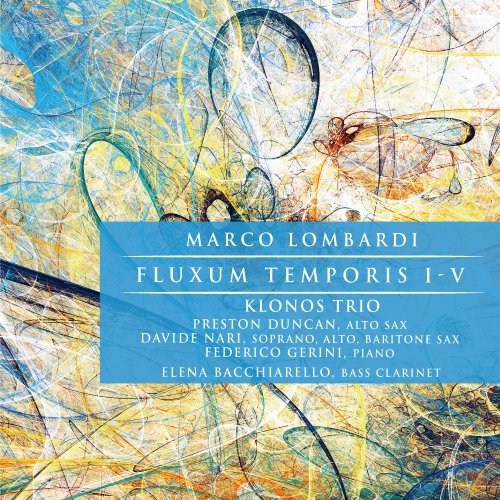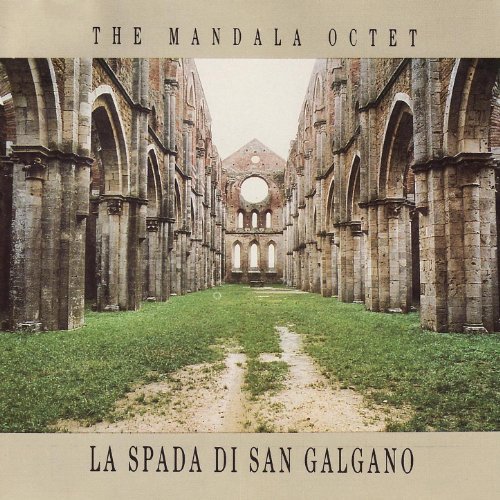Various Artists - Marco Lombardi: Fluxum Temporis I - V (2022)

Artist: Various Artists
Title: Marco Lombardi: Fluxum Temporis I - V
Year Of Release: 2022
Label: Da Vinci Classics
Genre: Classical
Quality: FLAC (tracks)
Total Time: 52:18 min
Total Size: 245 MB
WebSite: Album Preview
Tracklist:Title: Marco Lombardi: Fluxum Temporis I - V
Year Of Release: 2022
Label: Da Vinci Classics
Genre: Classical
Quality: FLAC (tracks)
Total Time: 52:18 min
Total Size: 245 MB
WebSite: Album Preview
1. Fluxum Temporis I (For Alto Saxophone)
2. Fluxum Temporis II "Toccata" (For Piano)
3. Fluxum Temporis III (For Alto Saxophone and Piano)
4. Fluxum Temporis IV (For Bass Clarinet and Baritone Saxophone)
5. Fluxum Temporis V (For 2 Saxophones and Piano)
The expression Fluxum Temporis is found in the commentary to the fourth book of Aristotle’s Physics written by Thomas Aquinas1 around 1270. Among the several titles I had in mind, all centered around various declinations of the word “time”, I chose this one for the following reasons. By studying the questions regarding “time” (ontological, daily, objective or subjective, physical or psychological: in sum, in its most general determination) and “musical time” (as a particular standpoint on the former) – their nature, their relation – one enters in contact with the innumerable considerations that succeeded each other in the history of Western thought. I therefore sought something shared by a sufficiently high number of them, and here is, then, the idea of Time’s Flow. Of course, one could say that time is “more” and “other” than a simple flow. However, many agree that, generally speaking, time is also this. The use of the same expression for the title of all five pieces, with the addition of Roman numerals, indicates the actualized constitution of a kind of a cycle, where unity and diversity are found in the same degree. On the one hand, in fact, beyond the general tone, there are no true connections among the five pieces, nor any progress or evolution is found from the one to the other. However, they are joined since each offers a “particular profile of musical time2, different from the others. At an elementary level, the difference between “time” and “musical time” is that the latter ends. This may seem, and perhaps indeed is, a trivial observation. However, at times, what seems trivial is worth considering in depth, since it may hide something that, at first sight, we risk missing. Let us consider that “musical time” (at least as concerns played music, if not actually written music), begins and ends in correspondence with the work. An entirely different matter, which I will not discuss here, regards its echo which remains in memory. Music therefore allows us to make a really special experience: i.e., the beginning and ending not of “time”, but of that specific declination of it which is called “musical time”. Now, since to compose, for me, means essentially to organize “musical time”, the transition from “time” to “musical time”, and hence again to “time” is of an extreme importance. I might dare say that the act of composition is nothing else than this: to put into relationship the time of “opening” and the time of “closing”; to imagine how “musical time” can indwell “time”, and how it can flow out of this. In sum, birth and death, rising and dissolving, making and unmaking of existence, i.e., finally, of form. In the present case, I could say that I began from the end rather than from the beginning, i.e., from how pieces close. The sinewy instrumental brilliancy characterizing the incipit of them all fades in their respective endings, according to two different ways originating a symmetry within the cycle. Pieces I, III, and V close due to a dissipation of energy. Contrariwise, pieces II and IV terminate because, at a given moment, one decides to stop. In the odd-numbered pieces the musical organism is, in a manner of speaking, subject to ageing, forcing life to extinguish itself little by little. Silence is of fundamental importance, or, rather the silences which mark, in the corresponding endings, the progressive and unavoidable affirmation of “time” over “musical time”. Following an elementary gestalt principle, they acquire the greater relief and importance, the more they are framed in what contradicts them. This, as will be heard, is nothing but an uninterrupted flow of notes. In the even-numbered pieces, instead, life suddenly ceases, traumatically, and with no apparent reason. While I am aware of the irreducible chasm between what the composer realizes and what gets to the listener, I will now propose some interpretive keys starting from what I deem to be the five piece’s main traits. It is likely that one of the first things that will become evident upon listening will be the phenomenon of repetition, often purposefully redundant, of an archétype (so, probably, Gérard Grisey would have indicated it). In the two Duo, this archetypal function is realized, respectively, by: some ten bars in the III piece, and, in the IV, by a single eptachord3. Their obsessive reiteration, far from any post-minimalist echo or nostalgia, should (or could: in both cases, the conditional is compulsory) produce as a consequence the abolition of material in favour of pure duration. This was one of the aims that the same Grisey had set for himself. Figuring to myself the reactions of a hypothetical listener, I supposed that there are three stages in the perception of a chain of repetition. Firstly, he or she realizes the repetitive machine, distinguishing between the model’s first apparition and its following returns. At the same time, they try and guess for how long this will continue: will changes intervene? Of what kind? Certainly, they do not expect the entire form to coincide with the continued reiteration of the archetypal fragment. Soon afterwards, it is likely that a sense of irritation will gradually arise against that increasingly obsessive mechanism. For our imaginary listener’s sensitivity and taste, repetition seems to continue for too long. This is evidently the most delicate stage, which risks to lead even to the ex abrupto interruption of the listening process, by turning off the CD player or going out from the concert hall. If this does not happen, the last stage is reached. It is a kind of an unknown land, whose profile can be traced back only to my own personal suppositions. Once the above-mentioned sense of frustration is overcome, a horizon opens up, where the repeated element is heard almost no more, leaving room for the perception of repetition as such. It is here, perhaps, that one can grasp, in spite of its unavoidably brevity and fleetingness, the “fragment of time in its pure state” indicated by Proust in a famous passage of Le Temps Retrouvé. The concept of repetition is a fortiori linked with the circular view of “time” which is traditionally opposed to the linear-teleologic view. This is certainly not the place for discussing this dichotomy in depth, and, indeed, it is much less rigid than one could imagine. There are, in these five pieces, numerous passages (for instance, the beginning of no. V) where the line, oriented toward a never-reached, and indeed unreachable telos, becomes curve, and, bending on itself, generates some micro-repeats. This linearity is neither finalized nor has a direction4. At times, it is interspersed by a single element which, interrupting it on several occasions, forces memory to mark, on its own map, the landmarks of the territory one has just crossed. For example, in Piece I, this happens with the “slap” note of the alto sax. Pieces II and IV, and, in particular, the piano Toccata, are the less articulated ones from the viewpoint of phrasing. Each of them, following a principle of vertical time, “does not begin, but rather ‘leaves’ […], does not end, but simply stops5. Both define, from the outset, the boundaries of their aural world, by recurring to instrumental gestures which will remain entirely unchanged up to the end.
Excusationes non petitae. Will the listener find what has been just said during the listening process? If not, will this be caused by my incapacity to render it evident in purely musical terms, or will it be due to the irreconcilable chasm between music and the discourse about it? Will that specific listener be the one who has not received what I believed to be evident? Will his or her attention be caught by something else? If these are not outrightly idle questions, they certainly will remain unanswered. As it always happens, also in Fluxum Temporis everyone will listen to what they want and to what they can. I wish, finally, to heartily thank Davide, Elena, Federico and Preston who, with their skill and sensitivity, gave an actual aural life to what I have just tried to illustrate. With them I also thank Gabriele for his valuable and irreplaceable work both in the recording studio and in the editing and mixing stages. And now… à l’écoute!
Marco Lombardi
Excusationes non petitae. Will the listener find what has been just said during the listening process? If not, will this be caused by my incapacity to render it evident in purely musical terms, or will it be due to the irreconcilable chasm between music and the discourse about it? Will that specific listener be the one who has not received what I believed to be evident? Will his or her attention be caught by something else? If these are not outrightly idle questions, they certainly will remain unanswered. As it always happens, also in Fluxum Temporis everyone will listen to what they want and to what they can. I wish, finally, to heartily thank Davide, Elena, Federico and Preston who, with their skill and sensitivity, gave an actual aural life to what I have just tried to illustrate. With them I also thank Gabriele for his valuable and irreplaceable work both in the recording studio and in the editing and mixing stages. And now… à l’écoute!
Marco Lombardi



![divr - Live At Cully Jazz (Live) (2025) [Hi-Res] divr - Live At Cully Jazz (Live) (2025) [Hi-Res]](https://img.israbox.com/img/2025-12/12/xmcmwpwdqm3q0bglwqr3joh4t.jpg)



![Tomasz Stanko, Polskie Radio - Jazz Rock Company: Live at Akwarium (Polish Radio Sessions vol. 6/6) (2025) [Hi-Res] Tomasz Stanko, Polskie Radio - Jazz Rock Company: Live at Akwarium (Polish Radio Sessions vol. 6/6) (2025) [Hi-Res]](https://www.dibpic.com/uploads/posts/2025-12/1765796554_cover.jpg)
![Tomasz Stańko - Unit (Polish Radio Sessions vol. 2/6) (2025) [Hi-Res] Tomasz Stańko - Unit (Polish Radio Sessions vol. 2/6) (2025) [Hi-Res]](https://www.dibpic.com/uploads/posts/2025-12/1765790300_cover.jpg)